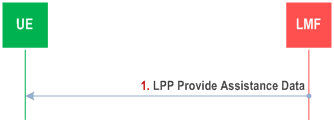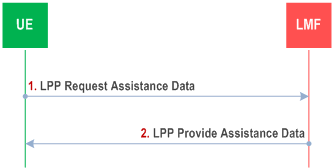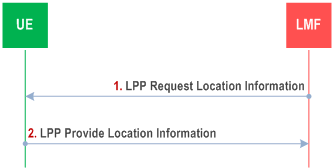Content for TS 38.305 Word version: 18.1.0
1…
4…
5…
6…
6.5…
6.7…
7…
7.3A…
7.4…
7.6…
7.11…
7.12…
8…
8.1.2.1a…
8.1.3…
8.2…
8.3…
8.4…
8.5…
8.6…
8.7…
8.8…
8.9…
8.10…
8.11…
8.12…
8.13…
8.14…
8.15…
A…
8.6 Bluetooth positioning
8.6.1 General
8.6.2 Information to be transferred between NG-RAN/5GC Elements
8.6.2.1 Information that may be transferred from the LMF to UE
8.6.2.1.0 General
8.6.2.1.1 Bluetooth beacon advertising address
8.6.2.1.2 Bluetooth beacon location
8.6.2.1.3 Bluetooth beacon antenna array orientation
8.6.2.1.4 Bluetooth beacon antenna array configuration and switching pattern
8.6.2.1.5 Bluetooth beacon AoD transmission configuration
8.6.2.2 Information that may be transferred from the UE to LMF
8.6.2.2.0 General
8.6.2.2.1 Standalone mode
8.6.2.2.2 UE-assisted mode
8.6.2.2.3 UE-based mode
8.6.3 Bluetooth Positioning Procedures
8.6.3.1 Capability Transfer Procedure
8.6.3.2 Assistance Data Transfer Procedure
8.6.3.2.0 General
8.6.3.2.1 LMF initiated Assistance Data Delivery
8.6.3.2.2 UE initiated Assistance Data Transfer
8.6.3.3 Location Information Transfer Procedure
8.6.3.3.0 General
8.6.3.3.1 LMF initiated Location Information Transfer Procedure
8.6.3.3.2 UE-initiated Location Information Delivery Procedure
...
...
8.6 Bluetooth positioning p. 109
8.6.1 General |R16| p. 109
In the Bluetooth positioning method, the UE position is estimated with the knowledge of geographical coordinate of reference Bluetooth beacons. This is accomplished by collecting a certain amount of measurements from UE's Bluetooth receiver and/or from the receiver of the Bluetooth beacons, and applying a location determination algorithm using databases of the estimated position's references points, reference points antenna configuration and orientation.
The UE Bluetooth measurements may include:
- Bluetooth beacon's Received Signal Strength (RSSI).
- Bluetooth beacon's estimated AoD (azimuth and zenith angles).
- Bluetooth beacon's estimated AoA (azimuth and zenith angles).
- Standalone: The UE performs Bluetooth position measurements and location computation.
- UE-assisted: The UE provides Bluetooth position measurements with or without assistance from the network to the LMF for computation of a location estimate by the network.
- UE-based: The UE performs Bluetooth position measurements and computation of a location estimate with network assistance.
8.6.2 Information to be transferred between NG-RAN/5GC Elements p. 110
This clause defines the information that may be transferred between LMF and UE.
8.6.2.1 Information that may be transferred from the LMF to UE p. 110
8.6.2.1.0 General |R18| p. 110
Table 8.6.2.1.0-1 lists Bluetooth transmission parameters that LMF may suggest to the UE to consider for UE-assisted Bluetooth AoA positioning. LMF may instead only request to the UE to provide its Bluetooth transmission parameters used for UE-assisted Bluetooth AoA positioning.
| Information |
|---|
| Transmission configuration (advertising periodicities, PHY type, TX power, CTE length and repetition) |
The AoA transmission configuration is described in more detail in clause 8.6.2.2.
Table 8.6.2.1.0-2 lists assistance data for both UE-assisted and UE-based modes that may be sent from the LMF to the UE to support Bluetooth AoD positioning.
| Information | UE-assisted | UE-based |
|---|---|---|
| Bluetooth beacon list: | ||
|
Bluetooth advertising address
| Yes | Yes |
|
Geographical coordinate
| Yes | Yes |
|
Antenna array orientation (LCS to GCS translation)
| Yes | Yes |
|
Antenna array configuration (antenna relative location and polarization) and antenna switching pattern
| Yes | Yes |
|
Transmission configuration (advertising periodicities, PHY type, CTE type, length and repetition)
| Yes | Yes |
8.6.2.1.1 Bluetooth beacon advertising address |R18| p. 111
This assistance data provides the Bluetooth advertising address btAddr of the Bluetrooth beacon [51].
8.6.2.1.2 Bluetooth beacon location |R18| p. 111
This assistance data provides the location of the Bluetooth beacon [51].
8.6.2.1.3 Bluetooth beacon antenna array orientation |R18| p. 111
This assistance data provides the Bluetooth antenna array orientation of the Bluetooth beacon by parameters bearing, downtilt and slant for the translation of a Local Coordinate System (LCS) to a Global Coordinate System (GCS).
8.6.2.1.4 Bluetooth beacon antenna array configuration and switching pattern |R18| p. 111
This assistance data provides the Bluetooth antenna array configuration of the Bluetooth beacon, where each the antenna of the array is characterized by a relative position to an antenna array reference point and a polarization, and the antenna switching pattern lists the order antennas are used for transmissions [51]. One generic antenna array and three parameterized antenna arrays can be defined (linear, rectangular or circular).
8.6.2.1.5 Bluetooth beacon AoD transmission configuration |R18| p. 111
This assistance data provides the Bluetooth beacon AoD transmission configuration parameters for the primary and secondary advertising periodicities, Bluetooth PHY type (1 or 2 Msymbol/s), CTE type (1 us or 2 us switching slot lengths), CTE length (8 to 160 us) and CTE repeated transmission instants (1 - 16).
8.6.2.2 Information that may be transferred from the UE to LMF p. 111
8.6.2.2.0 General |R18| p. 111
The information that may be signalled from the UE to the LMF is summarized in Table 8.6.2.2.0-1.
| Information | UE-Assisted | Standalone |
|---|---|---|
| Bluetooth Location Information | ||
| MAC Address | Yes | No |
| Received Signal Strength (RSSI) | Yes | No |
| Time Stamp | Yes | No |
| Measurement characteristics | Yes | No |
| AoD angles (azimuth and zenith | Yes | No |
| UE Location Information | ||
| UE position estimate with uncertainty shape | No | Yes |
| Position Time Stamp | No | Yes |
| Location Source (method(s) used to compute location) | No | Yes |
| UE AoA transmission configuration | ||
| Address and address type | Yes | No |
| Primary and secondary channel advertising periodicity | Yes | No |
| Primary and secondary advertising periodicity | Yes | No |
| TX Power | Yes | No |
| CTE transmission configuration | Yes | No |
Bluetooth AoA positioning is enabled by the UE transmitting Bluetooth periodic advertising with a CTE, configured by the following parameters:
- UE advertisement address that can be of three different types - public (MAC address), random-static (static random number) or random-private-resolvable (regularly updated random number);
- primary channel advertising periodicity, related to the Bluetooth beacon acquisition time of the UE Bluetooth signal;
- periodic advertising interval on the secondary advertising channel, related to how often the Bluetooth beacons will be able to estimate AoA of the UE;
- TX power related to how strong the UE Bluetooth signal is received at the Bluetooth beacons;
- CTE length (16 - 160 us) of every CTE transmission;
- CTE repeated transmissions instants (1-16) each transmission instant.
8.6.2.2.1 Standalone mode p. 112
In Standalone mode, the UE reports the latitude, longitude and possibly altitude, together with an estimate of the location uncertainty, if available.
The UE should also report an indication of Bluetooth method and possibly other location methods have been used to calculate a fix.
8.6.2.2.2 UE-assisted mode p. 112
In UE-assisted mode, the UE should either report:
-
The MAC addresses of the measured Bluetooth beacons and one or more of:
- associated RSSI;
- associated AoD, assisted by the positioning server.
- periodic advertisements with CTE to enable Bluetooth beacon AoA estimation.
8.6.2.2.3 UE-based mode |R18| p. 113
In UE-based mode using Bluetooth AoD, the UE reports the estimated location coordinates together with an estimate of the location uncertainty, if available.
The UE should also report an indication that Bluetooth method is used and possibly other positioning methods used to calculate the fix.
8.6.3 Bluetooth Positioning Procedures p. 113
8.6.3.1 Capability Transfer Procedure p. 113
The Capability Transfer procedure for Bluetooth positioning is described in clause 7.1.2.1.
8.6.3.2 Assistance Data Transfer Procedure p. 113
8.6.3.2.0 General |R18| p. 113
The purpose of this procedure is to enable the UE to request Bluetooth AoD assistance data from the LMF (e.g., as part of a positioning procedure) and the LMF to provide assistance data to the UE (e.g., as part of a positioning procedure).
8.6.3.2.1 LMF initiated Assistance Data Delivery |R18| p. 113
Figure 8.6.3.2.1-1 shows the Assistance Data Delivery operations for the network-assisted Bluetooth AoD method when the procedure is initiated by the LMF.

Step 1.
The LMF determines that assistance data needs to be provided to the UE (e.g., as part of a positioning procedure) and sends an LPP Provide Assistance Data message to the UE. This message may include any of the Bluetooth assistance data defined in clause 8.6.2.1.
8.6.3.2.2 UE initiated Assistance Data Transfer |R18| p. 113
Figure 8.6.3.2.2-1 shows the Assistance Data Transfer operations for the network-assisted Bluetooth AoD method when the procedure is initiated by the UE.

Step 1.
The UE determines that certain Bluetooth assistance data is desired (e.g., as part of a positioning procedure when the LMF provided assistance data are not sufficient for the UE to fulfil the request) and sends a LPP Request Assistance Data message to the LMF. This request includes an indication of which specific Bluetooth assistance data is requested.
Step 2.
The LMF provides the requested assistance data in a LPP Provide Assistance Data message, if available at the LMF. The entire set of assistance data may be delivered in one or several LPP messages. In this case, this step may be repeated by the LMF several times. If any of the UE requested assistance data in step (1) are not provided in step 2, the UE shall assume that the requested assistance data are not supported, or currently not available at the LMF. If none of the UE requested assistance data in step (1) can be provided by the LMF, return any information that can be provided in an LPP message of type Provide Assistance Data which includes a cause indication for the not provided assistance data.
8.6.3.3 Location Information Transfer Procedure p. 114
8.6.3.3.0 General |R18| p. 114
The purpose of this procedure is to enable the LMF to request position measurements or location estimate from the UE, or to enable the UE to provide location measurements to the LMF for position calculation.
The purpose can also be to enable LMF to request or suggest UE Bluetooth AoA configuration and enable the UE to provide the Bluetooth AoA configuration it will use to enable Bluetooth beacons to provide AoA measurements to LMF.
8.6.3.3.1 LMF initiated Location Information Transfer Procedure p. 114
Figure 8.6.3.3.1-1 shows the Location Information Transfer operations for the Bluetooth method when the procedure is initiated by the LMF.

Step 1.
The LMF sends a LPP Request Location Information message to the UE for invocation of Bluetooth positioning. This request includes positioning instructions such as the positioning mode (UE-assisted, Standalone), specific requested UE measurements if any, quality of service parameters (accuracy, response time), request/suggestion of UE Bluetooth AoA transmission configuration.
Step 2.
The UE performs the requested measurements and possibly calculates its own location. The UE sends an LPP Provide Location Information message to the LMF before the Response Time provided in step (1) elapsed. If the UE is unable to perform the requested measurements, or if the Response Time provided in step 1 elapsed before any of the requested measurements have been obtained, the UE returns any information that can be provided in an LPP message of type Provide Location Information which includes a cause indication for the not provided location information.
Alternatively, for AoA, the UE provides Bluetooth AoA transmission configuration that it will use in an LPP Provide Location Information message to the LMF before the Response Time provided in step (1) elapsed.
8.6.3.3.2 UE-initiated Location Information Delivery Procedure p. 115
Figure 8.6.3.3.2-1 shows the Location Information delivery operations for the Bluetooth method when the procedure is initiated by the UE.

Step 1.
The UE sends an LPP Provide Location Information message to the LMF. The Provide Location Information message may include UE Bluetooth information or location estimate already available at the UE. For AoA, the UE provides Bluetooth AoA transmission configuration in a Provide Location Information message that it will use. Specifically, the UE will trigger such a message when it has changed Bluetooth advertising address - only applicable for the random-private-resolvable address type.